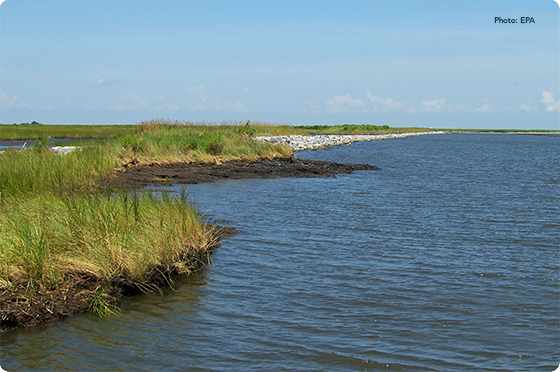
About forty percent of the continental United States’ wetlands lie within the boundaries of Louisiana. Since the 1930’s, the state has lost over 2,000 square miles of its total wetlands. This staggering land loss data demands attention, and the Louisiana government chose to respond in a big way— by devoting $61 million to rebuild crucial marsh habitat in St. Bernard Parish.
The funding for the project comes from the Natural Resources Damage Assessment (NRDA) program stemming from the Deepwater Horizon oil spill in 2010. Authority for the NRDA program stems from the Oil Pollution Act, which was enacted to restore the environment and natural resources damaged from oil discharges. Under the Oil Pollution Act, the NRDA program is the process used to develop a claim and compensation for damages caused by an oil spill. Following the death of 11 people and the release of 134 million gallons of oil from the Deepwater Horizon rig owned by oil company BP, the National Oceanic and Atmospheric Administration (NOAA) conducted what would become the largest NRDA ever. After a court approved an $8.8 billion settlement – the largest civil settlement ever awarded – with BP, the final restoration plan for the spill inspired several projects, including the Lake Borgne Marsh Creation (LBMC) Project.
Louisiana Governor John Bel Edwards announced the beginning of construction on Increment One of the LBMC Project on January 4. Louisiana’s Coastal Protection and Restoration Authority (CPRA), the state entity implementing the project, claims that this will be the largest marsh restoration project implemented by the CPRA to date. Lake Borgne, located northeast of New Orleans, is hydrologically connected to both the larger Lake Pontchartrain and smaller Lake Maurepas. The marshes of Lake Borgne, the outermost of the lakes to the Gulf, serve to filter tidal water and maintain water quality for one of the largest estuaries in the United States. While the degree of subsidence measured over the last ninety years is a sure threat to the estuary’s water quality, the LBMC seeks to reverse the trend in the area.
Engineering firm, Duplantis Design Group (DDG), and construction business, Mike Hooks, LLC, will join forces to carry out the LBMC and restore over 2,700 acres of new marsh. Using both earthen and non-earthen containment along with dikes, the project will deposit borrow material dredged from other areas in the region to fill spaces of open water. The newly filled areas will serve as a shield to protect existing marsh. The target areas for the project include marsh on the west side of Lake Borgne suffering from canal erosion and eastern marshes that are exposed to open water.
The beginning of the LBMC Increment One construction comes at an opportune time. In 2022, an aerial view of the lake shows a massive connection to the Mississippi Sound, with little remaining land on the east side. The large amounts of land suffering from subsidence in southern Louisiana affects water quality and, consequently, the overall health of the region’s wildlife. Additionally, subsidence reduces the amount of land protecting New Orleans from storm surges produced by dangerous hurricanes.
While years of speculation surrounds what specific actions have caused Louisiana’s marsh disappearance, who is to blame for it, and what can realistically be done to mitigate damages, the issue of subsidence in the region is indisputable. Marsh disappearance threatens the health of the estuary and in turn commercial fishing, tourism, recreation, and the culture of one of the earliest American settlements in the South. LBMC Increment One is a small step to heal this precious estuary and restore it to its natural condition.











